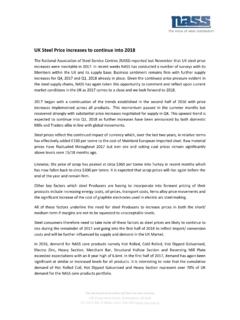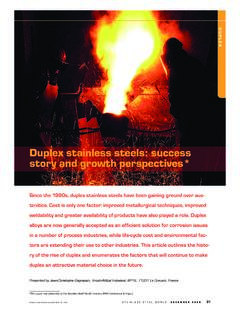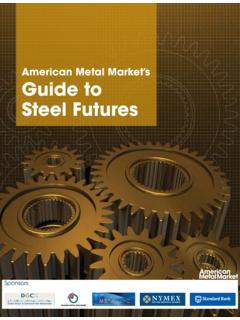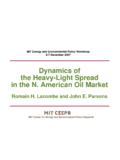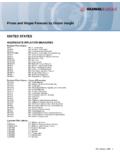Transcription of THE SOUTH AFRICAN IRON ANd STEEl vAlUE CHAIN
1 THE SOUTH AFRICAN iron ANd STEEl vAlUE CHAINKUMBA iron OREM arch 2011 BACKGROUNd TO KUMBA iron OREK umba iron Ore Ltd is the fifth largest supplier of seaborne iron ore in the world. Operating through its 74%-held subsidiary Sishen iron Ore Company (SIOC), Kumba has two operational mines at Sishen and Thabazimbi, with a third, Kolomela, scheduled to begin production in 2012. Kumba has a market capitalisation of R137 bn and is the 11th largest listed company on the JSE. Kumba generated revenue of bn in 2010, of which bn was from export sales; and operating profit of bn. SIOC, as its operating company, contributes significantly to the fiscus, paying taxes of bn (including secondary taxes).Kumba employs approximately 11 800 employees and contractors, and since 2007 has spent R368 m on skills development. Over the past two years, the company has created 37 new businesses and 360 new permanent jobs.
2 Through one of the country s most successful empowerment transactions, Kumba has made a significant contribution to broad-based transformation, which includes bn in dividends to empowerment partners since 2007. In addition, bn was spent on preferential procurement in 2010 and the company is compliant with the requirements of the Mining 1AN OvErvIEw Of ThE SOUTH AFRICAN iron ANd STEEl vAlUE ExECuTIvE SummAry CONTExT ANd purpOSE dESCrIpTION Of ThE vAlUE CHAIN 2 IN SOUTH AfrICA iron ore price as a competitive advantage IN duSTry pArTICIpANTS ANd 4 CONTrIB uTION TO SOUTH AfrICA, pEr STEp IN ThE vAlUE CHAIN Exploration and extraction and 4 mining beneficiation metallurgical beneficiation and shaping 6 Conversion/fabrication and 8 manufacturing/end user industries CurrENT pOSITION.
3 GrOwTh 11 prOSpECTS ANd CONdITIONS NEEdEd fOr SuCCESS Exploration and extraction and 11 mining beneficiation metallurgical beneficiation and shaping 12 Conversion/fabrication and 15 manufacturing/end user industries dETErmINING ThE wAy fOrwArd 16 The high road scenario 16 The low road scenario CONCluSION 17 CONTENTSSECTION 2 CrEATING A GrOwING ANd SuSTAINABlE iron ANd STEEl vAlUE CHAIN IN SOUTH ExECuTIvE SummAry GrOwING ThE iron ANd STEEl vAlUE 22 CHAIN ON A SuSTAINABlE BASIS: lessons from Australia and SOUTH Korea Australia economic and employment 22 growth through mining SOUTH Korea from poverty to a 24 flourishing manufacturing nation SOUTH Africa principles for creating 25 a sustainable iron and STEEl vAlUE OvErvIEw Of pOTENTIAl GrOwTh 27 OppOrTuNITIES Exploration & extraction and mining 27 beneficiation ( iron ore mining) metallurgical beneficiation and shaping 32 (steelmaking) Conversion/fabrication and 38 manufacturing/end users (downstream industries) ThE lOw rOAd SCENArIO 42 iron ore mining and mining beneficiation 42 ( iron ore mining) metallurgical beneficiation and shaping 42 (steelmaking)
4 Converters/fabricators and 43 manufacturers/end users (downstream industries) SummAry dETErmINING ThE wAy fOrwArd 44 AppENdI x 1 KumBA S ANAlySIS 45 SECTION 1AN OvERvIEw OF THE SOUTH AFRICAN iron ANd STEEl vAlUE CHAINKUMBA iron EXECUTIvE SUMMARYThe Ministers of Trade and Industry, Economic Development and Mineral Resources have established an interdepartmental task team (the Task Team) to make recommendations on appropriate policies to achieve certain developmental objectives related to the SOUTH AFRICAN iron and STEEl vAlUE iron Ore Limited (Kumba) is fully committed to and supportive of government s intentions to stimulate growth, employment and development across the iron and STEEl vAlUE CHAIN in SOUTH Africa.
5 Kumba believes that government interventions and policy considerations in this vAlUE CHAIN need to be carefully evaluated having regard to the relevant structural features and underlying factual considerations. In this paper, Kumba has sought to examine some of the most critical features of the iron ore, STEEl and STEEl consuming downstream industries and to highlight those considerations which could have an important bearing on formulating appropriate include: iron oreThe SOUTH AFRICAN iron ore industry is globally competitive, given the fact that a significant proportion of iron ore produced in SOUTH Africa is high quality and SOUTH Africa is geographically well positioned to export iron iron ore industry has the potential to more than double output in the next 10 years if appropriate conditions exist, including: The necessary logistics (rail and port) infrastructure is put in place; Secure availability of energy and water resources.
6 A viable market is available for a secure offtake of iron ore and STEEl products; Opportunities are available to generate an appropriate return on capital invested; and A suitable regulatory environment that encourages market participants to make the required growth projects are capital intensive and will not be economically viable without market related iron ore prices (at export parity price levels). iron ore prices do not materially influence STEEl prices in SOUTH Africa as STEEl is priced on the basis of international prices. Importantly, from a cost perspective iron ore currently only accounts for between 11 13% of ArcelorMittal s (AMSA) total STEEl production costs at interim prices. Other key input costs that are of greater significance for AMSA, include coking coal (up to 27%), labour (12%) and logistics SOUTH AFRICAN STEEl industry had approximately mt of STEEl production capacity with mt of spare STEEl capacity over domestic demand in 2008.
7 Various factors, including SOUTH Africa s distance from major export markets, mean that SOUTH AFRICAN STEEl producers are not cost competitive in these markets and that only mt of that excess STEEl capacity was able to be exported in opportunities are limited in the STEEl sector due to its current large size (relative to the economy), local over capacity and structural lack of export competitiveness of SOUTH Africa s STEEl manufacturing majority of SOUTH Africa s STEEl operations (particularly the mini mills) are currently either only marginally profitable or are in a loss making position. Accordingly, lower STEEl prices are likely to have an adverse impact on the viability of these beneficiationSouth AFRICAN converters and manufacturers are in most cases very competitive in domestic and regional markets, but would not be able to increase current levels of exports significantly, owing to high logistics costs and/or lack of than 85% of SOUTH AFRICAN STEEl is consumed in industry sectors for which STEEl s share of product vAlUE is typically very low (<5%).
8 Therefore, iron ore typically contributes less than 1% to the costs of these end products and is largely insignificant in its impact on overall costs of downstream products. Even if iron ore is discounted significantly, this has an immaterial impact on the cost of most downstream users. This should be weighed against the benefits of growing the iron ore industry by ensuring the viability of the Limpopo order to create a viable STEEl industry, the following are needed: Stimulation of local demand for STEEl in downstream industries, such as construction and mining; Ensuring that domestic STEEl producers are treated in an equitable manner without any undue preference being accorded to STEEl producers who use iron ore as their principal input; and Currently nascent technologies that may reduce SOUTH AFRICAN STEEl producers dependence on expensive imported coking coal should be explored to determine if they are commercially SOUTH AFRICAN iron ore and STEEl vAlUE CHAIN faces a number of possible outcomes that may range from or in between a high road scenario , in which the right supportive conditions exist to enable growth and job creation and a low road scenario , where the absence of supportive conditions results in stagnant growth.
9 These scenarios are discussed in more detail at the conclusion of this the facts set out above, one of the principal issues which Kumba would like to discuss with the Task Team in due course, is the link, if any, between STEEl pricing (and conceivably iron ore pricing) and the extent to which SOUTH Africa is able to promote downstream metal fabrication and manufacturing. Kumba is in the process of preparing more detailed papers on this issue for follow-up discussions with the Task iron and STEEl vAlUE CHAIN consists of four distinctive stages, spanning multiple industries: exploration and extraction, mining beneficiation, metallurgical beneficiation and shaping and conversion/fabrication and manufacturing/end user dESCRIpTION OF THE vAlUE CHAIN IN SOUTH AFRICAE xploration and extractionThe process of exploring for and then extracting iron ore (drilling, blasting, loading, hauling) is typically open pit mining performed by mining beneficiationAlthough some iron ore miners sell their iron ore directly to STEEl producers, referred to as directly shipped ore (DSO), most iron ore in SOUTH Africa is beneficiated through capital intensive dense medium separation or jigging by miners at the mine site, in order to convert the mined ore into a saleable product and/or to increase its vAlUE in use (VIU)
10 To local and international STEEl beneficiation and shapingThis process is performed by the STEEl manufacturing industry and typically involves smelting to convert iron ore into pig- iron (in SOUTH Africa primarily via the blast furnace route) and then refining (eg using a basic oxygen furnace) and shaping it in rolling mills into STEEl products (eg HRC - hot rolled coil). Other input materials in STEEl manufacturing are scrap, manganese and coking coal. The most expensive component in this process is coking coal (mainly imported into SOUTH Africa), which is used to produce coke, needed both as the chemical reductant and as the source of energy in the process. An alternate steelmaking technology also used in SOUTH Africa is the electric arc furnace (EAF) route. Although this process uses small quantities of iron ore, most of the iron is obtained from smelting scrap metal using significant quantities of electricity as the energy and manufacturing/end user industriesThis final step in the vAlUE CHAIN encompasses two groups of players: converters/fabricators that convert standard STEEl products into intermediate products (eg wire and tube); and manufacturers/end users that consume both standard STEEl products and intermediate products from converters.





